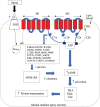ADCY5-Related Dyskinesia: Improving Clinical Detection of an Evolving Disorder
- PMID: 31538084
- PMCID: PMC6749814
- DOI: 10.1002/mdc3.12816
ADCY5-Related Dyskinesia: Improving Clinical Detection of an Evolving Disorder
Abstract
Background: The phenotypic spectrum of adenylyl cyclase 5 (ADCY5)-related disease has expanded considerably since the first description of the disorder in 1978 as familial essential chorea in a multiplex family.
Objective: To examine recent advances in the understanding of ADCY5-related dyskinesia and outline a diagnostic approach to enhance clinical detection.
Methods: A pragmatic review of the ADCY5 literature was undertaken to examine unique genetic and pathophysiological features as well as distinguishing clinical features.
Results: With over 70 cases reported to date, the phenotype is recognized to be broad, although distinctive features include prominent facial dyskinesia, motor exacerbations during drowsiness or sleep arousal, episodic painful dystonic posturing increased with stress or illness, and axial hypotonia with delayed developmental milestones. Uncommon phenotypes include childhood-onset chorea, myoclonus-dystonia, isolated nongeneralized dystonia, and alternating hemiplegia.
Conclusion: The ongoing expansion in clinical features suggests that ADCY5 remains underdiagnosed and may account for a proportion of "idiopathic" hyperkinetic movement disorders. Enhanced understanding of its clinical features may help clinicians improve the detection of complex or uncommon cases.
Keywords: ADCY5 mutation; episodic movement disorders; phenotypic spectrum.
Figures

References
-
- Perez‐Borja C, Tassinari AC, Swanson AG. Paroxysmal choreoathetosis and seizures induced by movement (reflex epilepsy). Epilepsia 1967;8:260–270. - PubMed
-
- Bird T, Carlson C, Hornung M. Ten year follow‐up of paroxysmal choreoathetosis: a sporadic case becomes familial. Epilepsia 1978;19:129–132. - PubMed
-
- Bird TD, Hall JG. Additional information on familial essential (benign) chorea. Clin Genet 1978;14:271–272. - PubMed
-
- Fernandez M, Raskind W, Wolff J, et al. Familial dyskinesia and facial myokymia (FDFM): a novel movement disorder. Ann Neurol 2001;49:486–492. - PubMed
Publication types
Grants and funding
LinkOut - more resources
Full Text Sources

